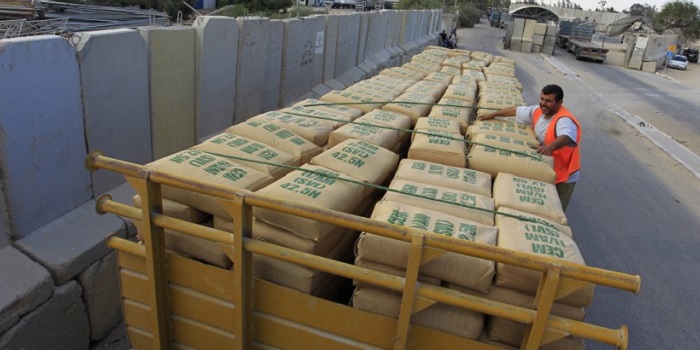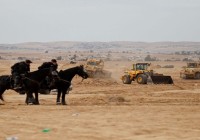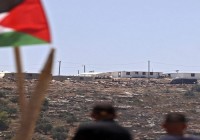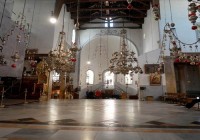Sanad: Price of Cement Ton to Increase by 20 Shekels in March

Hasnaa Al Rantisy – Palestine Economy Portal
Translated by Tamara Barakat
The news regarding the increase in cement prices angered the consumers, especially the real estate investment companies since this increase will surely reflect on the prices of apartments, as cement is a primary and indispensable building material in Palestine.
The Commercial Director at the Sanad Company, Hussein Yaseen, addressed the issue of the increase and explained the reasons behind it, and whether it will influence the real estate sector. He expected that the price of a ton of cement will increase by 20 shekels, and that this will be probably announced in the beginning of March.
The Supplier Increased the Price
90% of the cement demanded by the Palestinian market is imported from one primary supplier, the Israeli “Nesher Cement Enterprises.” Nesher increased the price of cement because the West Bank’s and Gaza’s need for cement increased beyond the company’s capabilities, forcing it to import the raw material instead of producing it itself. So, the company increased the prices in order to meet the new demand.
According to Yaseen, the Sanad Company was told last August to increase the price of the ton of cement by 35 shekels, and the number was later decreased to 30 shekels. However, after bitter negotiations, it was agreed to only raise the price by 20 shekels.
Yaseen explained that there was an increase in the price last year, but it did not affect the cost of cement. However, this year, it will affect the cost in order to “maintain a profit margin.” He also thought that the increase in the price is not very big.
What Does the 20-Shekel Increase Mean?
Cement is a primary material and the largest portion of the cost of a concrete cubic meter is attributed to it. The increase in the price of a ton of cement by 20 shekels will lead to an increase in the price of a concrete cubic meter by 7 shekels only.
Yaseen explained, “Each ton of cement equals 3 cubic meters of concrete, consequently the 20-shekel increase will lead to a 7-shekel increase in the price of a concrete cubic meter. And so, the increase will not be very big and will not exceed 3% of the cost. The price of the cubic meter of concrete will increase from 315 to 322 shekels.”
The Palestinian Consumption of Cement
The Palestinian market, excluding the Gaza Strip, consumes 2 million and 200 thousand tons of cement. Yaseen estimated Gaza’s current demand for cement at 500-700 thousand tons due to the current conditions and the closing of the crossings. Consequently, the overall consumption of cement in the West Bank and the Gaza Strip is around 3 million tons.
Israel supplies the majority of this amount due to the limitations and obstacles imposed by the protocols signed with Israel.
Yaseen explained, “We are forced to rely on Nesher as our supplier since it is the sole producer of cement in Israel. The supplied amount is provided through Israeli merchants or through Nesher, which enjoys a monopoly over the supply of cement to the West Bank and Gaza. Moreover, cement is imported to Palestine from Jordan within the permitted quota of 200 thousand tons.
The individual’s consumption of cement is estimated at 548 kilograms/year. In the West Bank, the average consumption increases further by another 100 kg since it consumes larger amounts due to accelerated construction. For example, in Ramallah, the individual’s average consumption of concrete is 1500 kilograms, which is higher than the individual’s average consumption of concrete in Dubai. In fact, it is the highest average of concrete consumption in the Middle East. This leads to a high degree of competition in Ramallah, reflected in the fact that there are 10 concrete factories that consume 260 tons of cement annually.
Effect on the Real Estate Sector
Yaseen sees that the increase in cement prices should not affect or lead to a great increase in the prices within the real estate sector. The cost of a house with an area of 120 meters will increase by around 1400 shekels (around 400 dollars) due to the increase in cement prices.
He emphasized that if the consumer was demanded to pay anything higher, this would not be caused by the increase in cement prices, but rather by the fact that some parties might take advantage of the increase and use it as a justification to raising the prices of apartments, buildings and facilities.
A cubic meter of concrete is sold for 350 shekels in Hebron, and for a similar price in Tulkarem, Nablus, and Jenin as well. In Ramallah, it is sold for around 290 shekels, even though Ramallah’s consumption of cement amounts to 33% of its overall consumption in Palestine. However, Ramallah is characterized by accelerated construction and high competition.
Yaseen concluded the interview by commenting on the increase in the prices of some building materials, such as sand, and expressed his surprise at the fact that no one is addressing this issue. We consume around 6 million tons of sand annually, and it is a primary material in the production of concrete. And the price of a ton of sand increased to around 40 shekels.
Moreover, the price of a ton of iron was 6 thousand shekels, but it decreased to 1950 shekels. However, this decrease did not affect the prices of apartments, although the amount of iron consumed in the construction of buildings is double that of cement.


